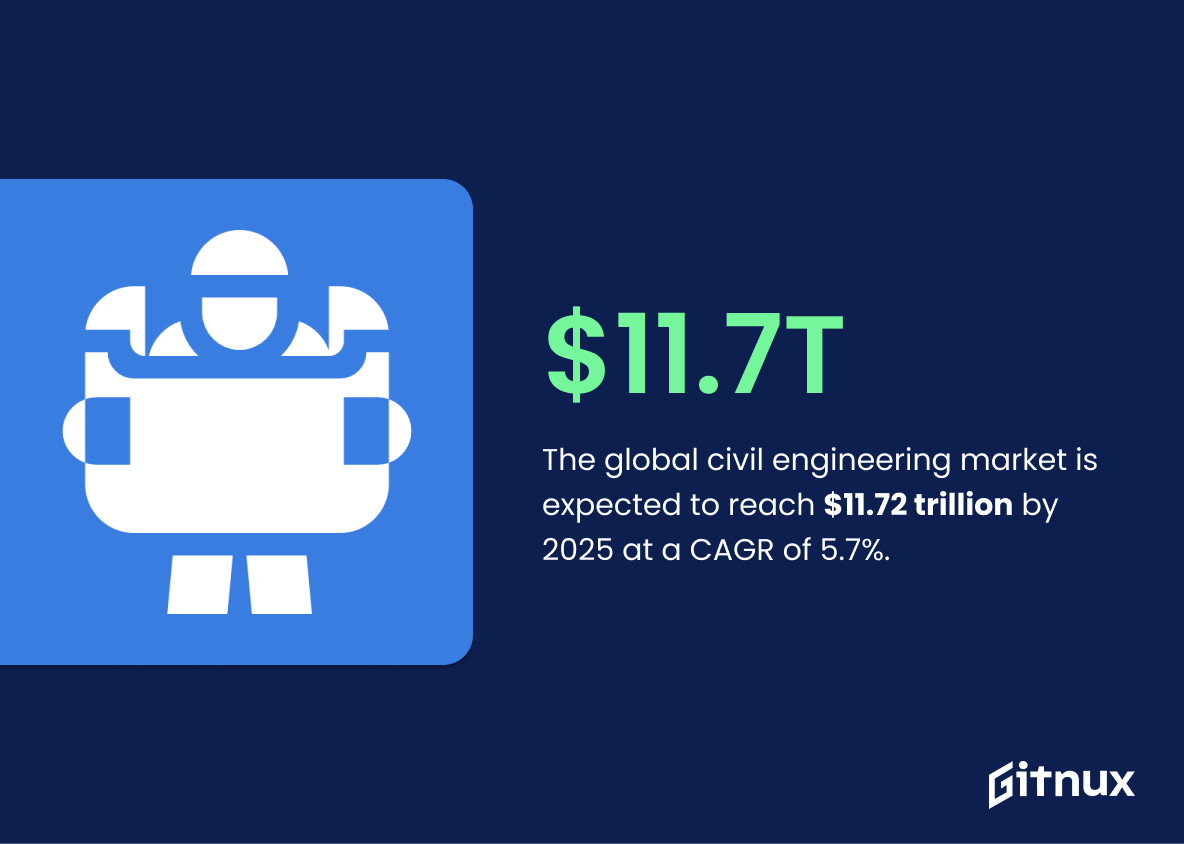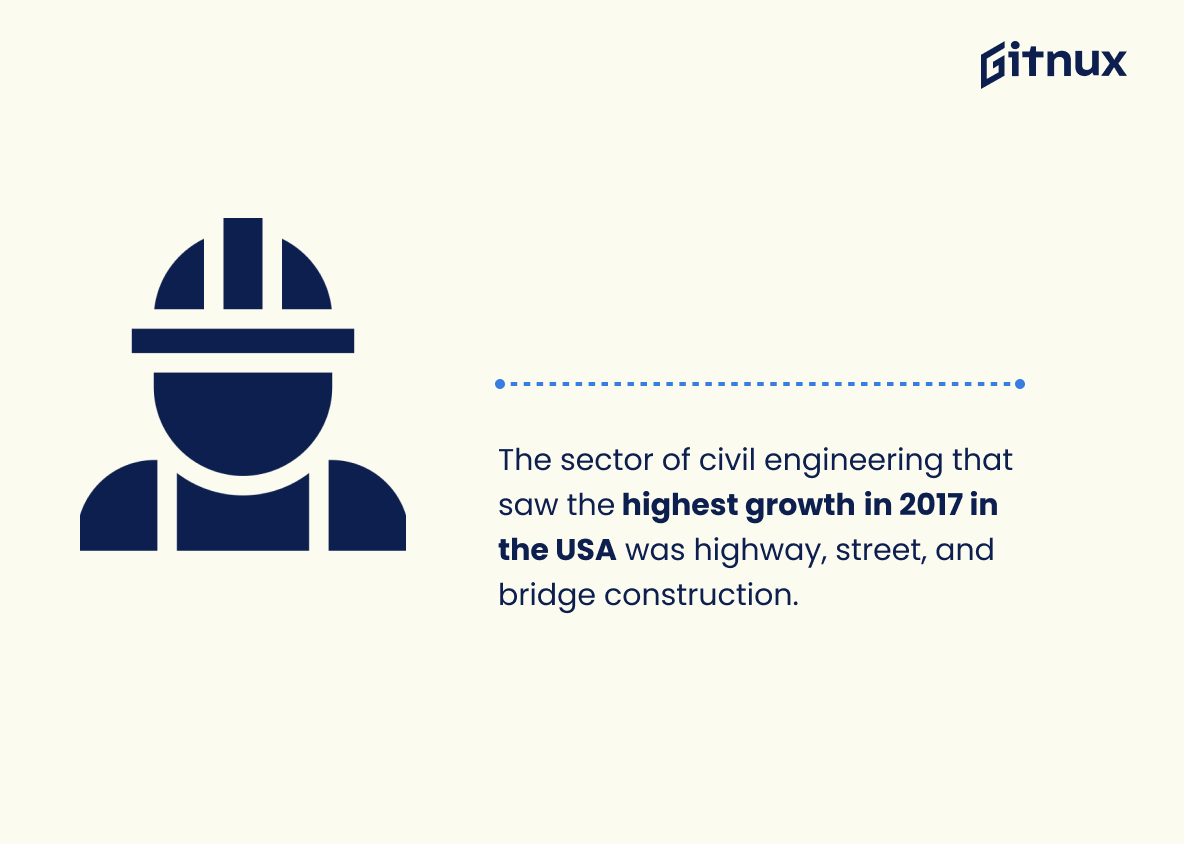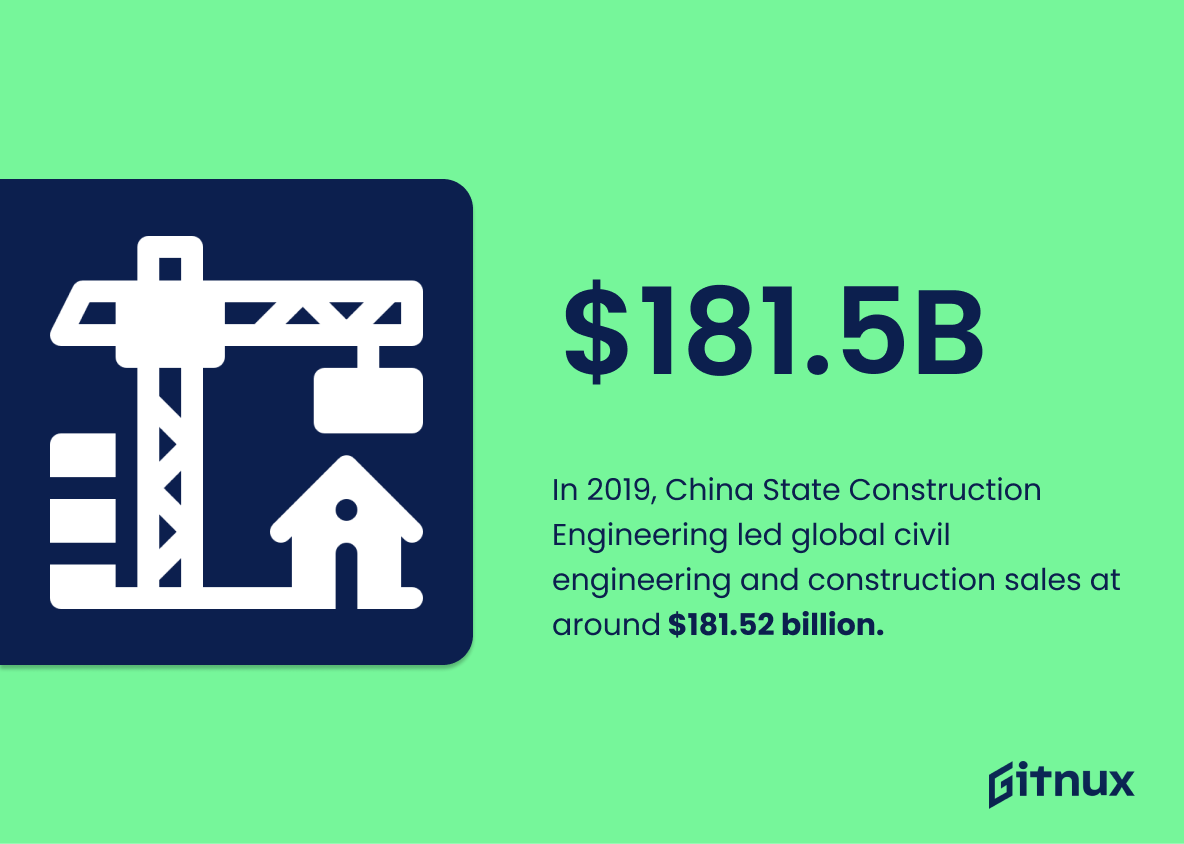Navigating the complex world of civil engineering is hardly a simple task. This multifaceted industry, which plays a pivotal role in shaping our modern infrastructure, is constantly evolving in response to technological advancements, economic trends, and societal needs. By exploring civil engineering industry statistics, we can unlock a myriad of insights about its current state, emerging trends, and future outlook.
This post promises to delve into these numbers, interpreting what they mean for both industry professionals and those who rely on their services. So, whether you’re a civil engineer seeking industry updates or simply an individual intrigued by the world of infrastructure development, get ready to dive into a comprehensive statistical analysis. It’s time to bridge the gap between numbers and understanding, enhancing our view of the world of Civil Engineering.
The Latest Civil Engineering Industry Statistics Unveiled
The global civil engineering market is expected to reach $11.72 trillion by 2025 at a CAGR of 5.7%.
This projected figure of $11.72 trillion for the global civil engineering market by 2025, increasing at a CAGR of 5.7%, paints a vibrant and optimistic picture of the industry’s future. It essentially acts as a beacon to students looking to step into the civil engineering field, to investors contemplating where to put their money, and to governments thinking about infrastructure investment.
This anticipation of substantial market growth foregrounds opportunities for innovation, development, and jobs. Through this lens, the quantitative appraisal becomes more than a statistic—it becomes a roadmap for strategic planning and actionable decisions in the versatile arena of civil engineering.
The United States represents the largest market for civil engineering, in terms of geography.
Unveiling the United States as the geographical behemoth in the civil engineering market assists in painting a vibrant scene of the industry’s landscape. This vivid depiction turns an abstract concept into a tangible reality for readers. It emphasizes the enormous potential of the U.S. market, providing a launching pad for detailed analysis of the sector’s growth factors, challenges, and future outlook.
This substantial fact broadens readers’ understanding to not only acknowledge the U.S. is the largest market, but also motivates them to delve deeper into the reasons and consequences. It triggers curiosity, paving way for informative discussion about structures, systems, and constructions that form the bedrock of a nation’s growth and the pivotal role the U.S. plays in spearheading the civil engineering industry.
When drawing comparisons with other geographical markets, this assertion assists in gaining a well-rounded perspective. The statistic acts like the North Star, illuminating the intricacies of the Civil Engineering Industry, while etching the might and dominance of the United States in readers’ minds.
In 2021, the civil engineering industry in the UK was worth about 22.6 billion euros.
Painting a vivid picture of the Civil Engineering landscape in the UK, the staggering value of 22.6 billion euros in 2021 alone reveals the immense economic contributions and vital role this industry plays. It is akin to a formidable titan, driving expansive growth while laying the groundwork for socio-economic development.
Each euro in this figure speaks volumes about the scope of infrastructural projects, scale of employment, and the continuous influx of technological innovations in this field. Thus, this number serves as a beacon, guiding readers to appreciate the tremendous influence and potential of the Civil Engineering industry.
China owns more than 50% of the global civil engineering market.
Unveiling the portrait of the global civil engineering landscape, an impressive fact sketches itself on the forefront – China’s command over more than half of the worldwide market. In the lively discourse of Civil Engineering Industry Statistics, this fact carries considerable weight. With China painting more than half of this scenic industry landscape, it reflects the country’s prowess, influencing global trends and technological advancements in this field.
This highlights not just the progress of Chinese civil engineering, but also the scale at which overseas companies must operate to make a significant impact in this industry. Understanding China’s supreme role provides a stepping stone for anyone looking to comprehend the industry’s dynamics, creating a compelling narrative about where the opportunities, challenges, and future of global civil engineering lie.
In 2019, the revenue of civil engineering in the U.S. was around 240 billion U.S. dollars.
The eye-catching figure of 240 billion U.S. dollars as the revenue of civil engineering in the U.S. in 2019 serves as a testament to the monumental scale and financial potency of this sector. Such a figure underscores the fact that the civil engineering industry is not just a peripheral player, but a vital heavyweight in the national economy.
The reality spelled out by this number also illuminates the degree of investment coming into the sector and implicates a corresponding demand in infrastructure development and maintenance. It provides valuable insights into the present capacity of the industry while setting a comparison marker for future growth trends. The sheer heft of this statistic effectively paints the big picture of the industry’s financial health while acting as a substantial data point rooted firmly in fiscal reality.
The Asia Pacific is expected to exhibit a 6.36 % CAGR in the forecast period in the civil engineering market.
Illuminating the potential future of the civil engineering landscape, the anticipated 6.36% CAGR in the Asia Pacific region beckons towards prevalent opportunities for growth. In the canvas of civil engineering industry statistics, this metric serves as a crucial brushstroke that not only highlights the industry’s pace but also identifies the Asia Pacific as a significant contributor.
The statistic becomes especially instrumental when strategizing business decisions, as it reflects the area’s burgeoning market potential and aids in assessing the regional economic environment. From identifying trends to potential investment decisions, this growth prediction acts as a compass, guiding stakeholders in their quest to capitalize on the industry’s prospective vibrancy.
The largest sector within civil engineering in the U.K in 2018 was structural, earning a revenue of about 2.7 billion GBP.
Highlighting the dominance of the structural sector in the U.K’s civil engineering industry in 2018, with a revenue generation of approximately 2.7 billion GBP, underlines the pulse of the industry at that time. It offers a snapshot of the industry’s health and direction, providing a benchmark for evaluating its performance.
Additionally, it serves as a beacon, guiding future investment decisions or pointing towards potential areas of growth and development. Furthermore, for aspiring civil engineers or professionals planning to switch specializations, this information offers valuable insights into lucrative avenues within the industry.
The sector of civil engineering that saw the highest growth in 2017 in the USA was highway, street, and bridge construction.
Showcasing the ascent of the highway, street, and bridge construction sector in 2017 within the broad landscape of civil engineering industry in the USA, profoundly exemplifies the dynamic nature and progress within the industry. This data helps illuminate the nuanced shifts and trends occurring within the sector, providing crucial insights to readers about which specialized areas of the market are undergoing expansion. In the grander scheme of things, it adds an extra layer of understanding about the civil engineering industry’s health and growth direction, a vital aspect for readers interested in career prospects, investment opportunities or simply building an in-depth understanding of the industry.
Over 290,000 people were employed in the civil engineering industry in 2019 in the USA.
Highlighting the number of employment opportunities, our selected statistic paints a vivid picture of the thriving civil engineering industry in the USA during 2019. This fact doesn’t just serve as an encouraging reminder of the industry’s robustness, but also underscores its significant contribution to the American workforce and economy.
In essence, the substantial employment figure becomes a testament to the industry’s stability and allure, and serves as a potential forecast for anyone considering a career in this dynamic field. This revelation about industry health could also boost investor confidence, making it even more pivotal in discussions of civil engineering industry statistics.
The Australian civil engineering industry is projected to grow at an annualized 0.6% over the five years through 2025-26, to $54.3 billion.
Projecting forward into the future, the Australian civil engineering industry appears to be entering an era of steady growth. An annualized rate increase of 0.6% through 2025-26 indicates that opportunities will continue to proliferate for new and established engineers.
By reaching a total expected value of $54.3 billion, this demonstrates that the industry vision for invigorating infrastructural projects, stimulating economic growth, and fostering development in Australia is more than just pipe dreams. This shining prediction serves as a beacon for investors, students, and professionals alike, illuminating the tangible potential that underlies this groundbreaking industry.
The leading company in the civil engineering and construction sector worldwide in 2019 was China State Construction Engineering, with total sales approximating 181.52 billion U.S. dollars.
Emerging as an undeniable powerhouse, the China State Construction Engineering achieved a striking sales approximation of 181.52 billion U.S. dollars in 2019, taking the helm as the world’s top company in the civil engineering and construction sector. This gargantuan figure not merely showcases the financial capability of this company; it also invokes a larger narrative about the global landscape of the civil engineering and construction industry.
It emphasizes the progressive gravitational shift toward Asian giants in the field, thus recontextualizing the traditional Western domination. In view of this, any robust discussion about Civil Engineering Industry Statistics should consider this profound shift and the economic ramifications it signifies.
In 2019, civil engineering contributed close to £150bn to the UK economy.
This evocative monetary figure shines a light on the indomitable presence that civil engineering holds in the UK economy. A staggering £150bn contribution in 2019 not only delineates the industry’s substantial impact but also underscores the profound role of civil engineering in shaping and sustaining the economic structure.
This figure could be seen as the heartbeat of the blog post, helping to animate a vivid image of the civil engineering industry, instilling in readers a recognition of its economic might and its indispensable position in the financial landscape of the United Kingdom. This colossal contribution also carries implications for job creation, infrastructure development, and socio-economic advancement, translating into tangible and intangible benefits that ripple throughout society.
Jobs in the civil engineering sector are projected to grow 2% from 2019 to 2029 in the USA.
Delving into the significance of this statistic, it paints an evolving landscape within the US civil engineering industry over the coming years. A projected 2% growth in jobs from 2019 to 2029 signifies not just an incremental demand for civil engineers, but also subtly underscores the continuing relevance of this industry to the nation’s development.
Woven within the features of a blog post on Civil Engineering Industry Statistics, this specific statistic provides a growth forecast that could be instrumental in guiding career aspirants, educational institutions, policy-makers, and employers alike. It furnishes a crucial piece to the puzzle when understanding the future trajectory of the civil engineering industry, potentially steering career pursuits, curriculum focus, policy direction, or workforce planning correspondingly.
The civil engineering industry in Australia employs approximately 120,000 people.
Peering behind the numbers, the noteworthy statistic of Australia’s civil engineering industry employing approximately 120,000 individuals does more than just draw a portrait of the sector’s size. On the canvas of a blog post focused on industry statistics, this number acts as a lighthouse, guiding readers to appreciate not just the magnitude of the industry’s workforce, but also its interwoven significance in the economic fabric.
This number not only represents jobs, but it also symbolizes the many families sustained, the educational establishments supported, and Australia’s national economy being propelled. Stepping into the light of this figure, readers can better comprehend the bearing this industry holds on individual lives and the Australian economy as a whole.
The Middle East and Africa civil engineering market size was valued at USD 791.01 billion in 2017.
The valuation of the Middle East and Africa civil engineering market at a staggering USD 791.01 billion in 2017 paints an impressive picture of prosperity within the civil engineering industry. This notable figure truly reflects the immense investments and dynamic projects undertaken in these regions, fueling the growth of the industry on a global stage.
From the construction of grandiose skyscrapers to innovative public infrastructure, this statistic offers a testament to the engineering marvels achieved and the vast economic implications tied to this field. A blog post exploring civil engineering industry statistics would certainly be enriched by such a substantial figure, providing a clear indication of the market’s substantial influence and potential for future growth and advancements.
On average, civil engineers in the U.S. earn about $84,770 annually.
Shining a spotlight on the average annual income of civil engineers in the U.S. offers a tangible insight into the monetary value that the industry puts on this profession. It furnishes a numerical benchmark for those considering a career in this field, allowing potential civil engineers to set realistic financial expectations.
Not only that, it also provides a comparative barometer, allowing readers to compare how civil engineering squares up against other professions. In turn, this figure may help to attract top talent, strengthen the industry and shape educational choices.
Russia’s civil engineering market value was approximately $108 billion in 2018.
Highlighting the magnitude of Russia’s civil engineering market value at approximately $108 billion in 2018 underscores the economic weight and significance of this sector. This figure gives the spotlight to Russia’s booming construction industry by offering a solid benchmark, reflecting the immense spending power and investment directed towards civil engineering projects.
It’s like throwing a giant spotlight on an often-understated industry, bringing clarity to its real potential and implications on a global scale. The potency of this number doesn’t just inflame interest but also underpins critical decision-making processes for individuals and corporations considering a venture in this industry.
Latin American civil engineering market is expected to grow from $214.58 billion in 2020 to $224.88 billion in 2021 at a compound annual growth rate (CAGR) of 4.8%.
By casting a spotlight on the promising predictions for the Latin American civil engineering market, this particular statistic serves as a powerful testament to the industry’s resilience even in the face of a global pandemic. It elucidates the potential for growth and progress within the market, highlighting a near two-digit-billion dollar increase within just a year. A 4.8% Compound Annual Growth Rate (CAGR) underlines that this is not a stagnant or declining market, but one which is expanding at a steady pace.
Therefore, for industry professionals, investors, or aspiring civil engineers, this growth trajectory offers an optimistic outlook on prospective opportunities and the overall health of the industry within Latin America. This statistic propels an understanding of the vitality and importance of the civil engineering industry, serving as the heartbeat in a broader discussion of industry statistics.
Conclusion
To sum up, the civil engineering industry plays a crucial role in shaping our infrastructure and modern societies. The statistics highlighted throughout this blog post illustrate the robust growth and importance of this sector in an evolving global landscape. From rising employment rates to increasing infrastructure budgets, these numbers underline a thriving industry harboring immense potential.
Whether you’re an aspiring civil engineer, a seasoned professional, or a curious observer, understanding these statistics can help foresee future trends, career paths, and potential opportunities in the vibrant world of civil engineering. Let’s keep a keen eye on this dynamic industry as it continues to mold and impact our world.
References
0. – https://www.www.businesswire.com
1. – https://www.www.ibisworld.com
2. – https://www.www.grandviewresearch.com
3. – https://www.www.globenewswire.com
4. – https://www.adata.org
5. – https://www.www.statista.com
6. – https://www.www.bls.gov
7. – https://www.www.reportlinker.com
8. – https://www.constructible.trimble.com
9. – https://www.www.servicesaustralia.gov.au
10. – https://www.www.marketwatch.com















